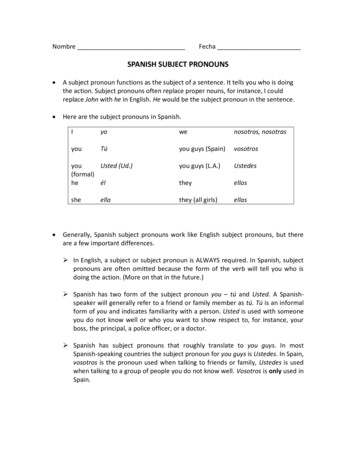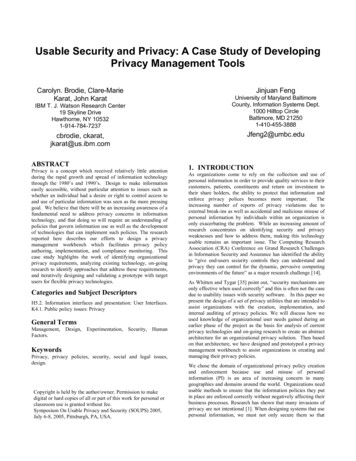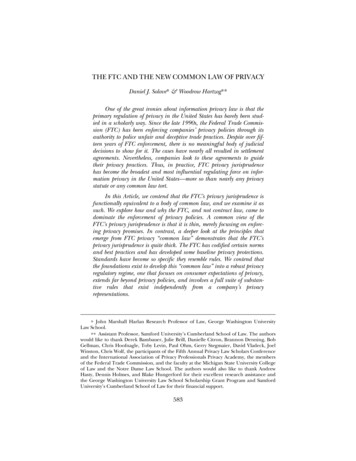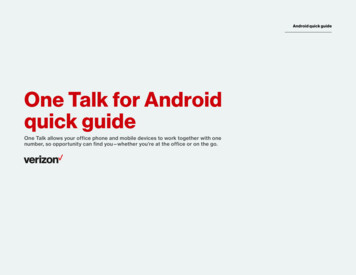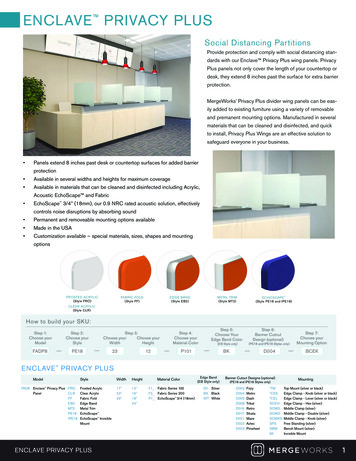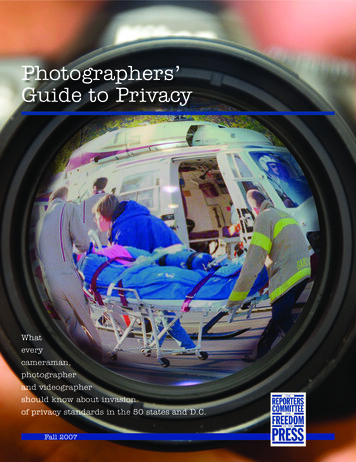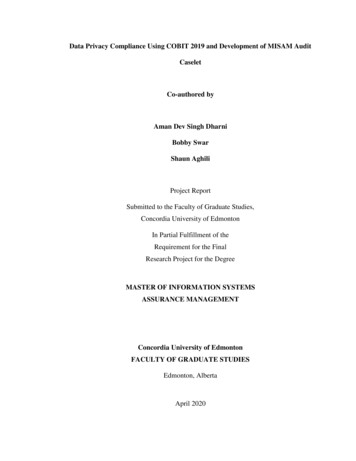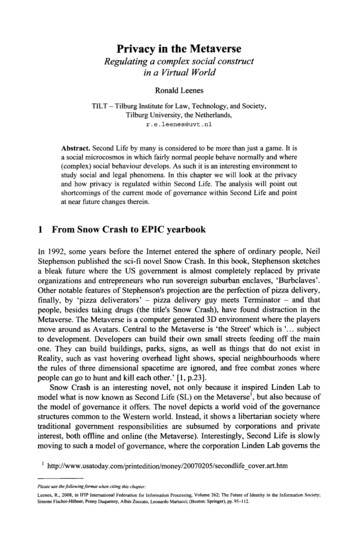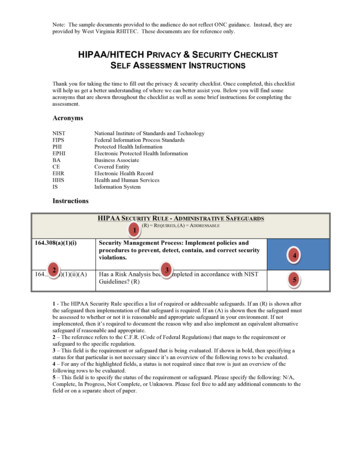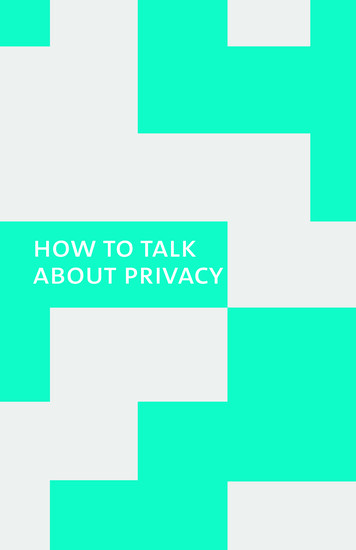
Transcription
how to talkabout privacy
If you are reading this guide you know privacy is an important topic for libraries,and you also know that others might not necessarily share the same history,professional principles, understanding, or interest as you. Finding ways tocommunicate the importance of privacy and why libraries should care is a criticalway to make needed changes, leading to safer environments for library users,library staff, and our communities. This guide is meant to help you consider thebest way to communicate about privacy by thinking about the people you aretrying to reach. It will also provide you with suggestions on the best messaging touse with various constituencies and stakeholders.25Who Are You Trying To Reach? . . . . . . . . . . . . . . . . . . . . . . . . . . . . . .6General Talking Points . . . . . . . . . . . . . . . . . . . . . . . . . . . . . . . . . . . . . .8Getting Your Privacy Point Across . . . . . . . . . . . . . . . . . . . . . . . . . . .10Creating Persuasive Arguments . . . . . . . . . . . . . . . . . . . . . . . . . . . .11Library Privacy Advocacy . . . . . . . . . . . . . . . . . . . . . . . . . . . . . . . . . . .12Case Studies . . . . . . . . . . . . . . . . . . . . . . . . . . . . . . . . . . . . . . . . . . . . . . .14Talking About Privacy . . . . . . . . . . . . . . . . . . . . . . . . . . . . . . . . . . . . . .3
Who Are You Trying To Reach?Empathy MapWhen speaking about privacy concerns, you needto understand the motivations and interests ofthe group or individual you are communicatingwith. Possessing this understanding will make theconversation easier and more successful. Knowingyour audience will help you talk about privacy in aexerciseOnce you fill out yourEmpathy Map, answer:Who are you trying to talkto?way that is meaningful for them, not just for you. Youwill be adjusting your talking points and tactics onceyou understand who you are talking to, what theymay already know, and what they care about.One quick way to understand who you are talking tois by using an empathy map. An empathy map is aWhat motivates themregarding privacy?tool to better understand where someone or a groupis coming from and how they see a particular issue,like privacy. While empathy maps are often derivedfrom interviews with an individual, you may be ableto learn more by filling in what you know and whatyou can learn about a person or group.What message could createa hook to interest them orto influence their view ofprivacy?exerciseThink of a stakeholder (an individual, group,community member, trustee, etc.) you need totalk to about a privacy-related concern. Fill out anempathy map. Templates are easily available onlineor draw your own based on the image in this guide.Think about what might motivate them, what mightthey already know, and why they would care aboutThis is a sample empahty map. Use it to help you better understandprivacy.the motivations of those you’re trying to reach.45
General Talking PointsNow that you have a good idea of the “who,” below are highlevel messages and conversation starters. It’s helpful to havesome talking points that have already been gathered by andfor the library community. Consider these as you think aboutthe empathy map exercise you just did.exerciseWould these talking points beuseful for your group or personyou are trying to talk with?Which ones might resonate ornot? Why? Alternatively, thinkabout your audience. What othertalking points can you think ofPrivacy is essential to the exercise of free speech, free thought and freeassociation.Privacy is a human right.that might resonate more withyour audience? Write yourthoughts below.Lack of privacy and confidentiality discourages individuals’ choices aboutwhat they read or view, thereby suppressing access to ideas and how theylearn in the world.Libraries are a cornerstone of democracy and help ensure Americans areable to read, research, and think freely.The possibility of surveillance, whether direct or through access to recordsof speech, research and exploration, undermines a democratic society.Systems reflect the biases of their creators and biases the ways data iscollected and used.The library community recognizes that children and youth have the samerights to privacy as adults.Most states have statutes declaring library records as confidentialdocuments. The two remaining states, Hawaii and Kentucky, haveopinions issued by their attorneys general finding library records to beconfidential documents.Librarians have a responsibility to protect the privacy of our users whileresponding to national security concerns within the framework of thelaw.It’s an equity issue -- individuals should have the ability to give consent tobe surveilled or not. This type of permission should not be held by only theprivileged few.67
Getting Your Privacy Point AcrossSometimes we only have a few minutes (or less) to create enough interest for theconversation to continue. Creating a succinct elevator speech can go a long way ingetting and keeping attention while quickly summarizing the idea or argumentyou are trying to convey. It should be interesting and concise. Ideally, it shouldalso be memorable so your message is not forgotten. Here’s a quick way to createan elevator speech:exampleLet’s say you’re looking to get in front of a board or campus assessmentcommittee making a decision on a new analytics tool. You have just a fewminutes with one of the members of the board or committee. Your goal is toconvince this person that you have privacy concerns and would like to addressthe larger group to further the discussion on this product. You might say, “IDetermine your goal. What is the end goal of this brief conversation?know you and the board are deciding on product X for the library. There’s someConsider including a talking point (like those listed in the previous section)that will grab their attention.privacy concerns for our users with that product. Did you know research showsSummarize your argument or the point you are trying to make in as short away as possiblewhere we allow freedom of thought, uncensored. In fact, it’s part of the AmericanEnd with what you believe to be the solution and possibly how you can helpthem get there.You may also want to include a “next step” so there’s a clear next action.being tracked makes people self-censor? Libraries are one of the few places leftLibrary Association’s Bill of Rights that we advocate for, educate about, andprotect people’s privacy, safeguarding all library use data, including personallyidentifiable information. I know this is a complex issue and I would love topresent this perspective to the board/committee for consideration.”exerciseUse the talking points provided, or create your own, to write an elevator speech for yourtargeted group or individual.An elevator speech is a short description that communicates a concept oridea in a way that a listener can understand it in a short period of time.89
Creating Persuasive ArgumentsLibrary Privacy Advocacy“I don’t have anything to hide.”Maybe talking with others about privacy concerns has you feeling like you would“Privacy is dead.”like to do more at your library, or even be part of a broader set of advocacy work“I care about my privacy but it’s too late to do anything about it.”on privacy-related issues. Below are ways to be a library privacy advocate:“Why do libraries care about my privacy?”“We don’t have the budget for privacy initiatives.”These are just a few of the reactions you might get when you start to engageTalk about privacy. This goes a long way in normalizing privacy as somethingto think about and discuss.Say something when you see something.library users, library staff, administration, stakeholders, or even your neighborsPush back against non-privacy conventions.on topics related to privacy. Awareness of the value of privacy has become moreBuild and use the collective voice. Find like-minded people or organizationswhere you can find others in support of privacy values.mainstream as we hear about data breaches and tech companies’ use of our data.the true scope of the threat to one’s privacy; indeed users may not yet understandEducate and teach others. This could even be sharing an article with coworkers.that there are a myriad of small things we can do to protect our own or ourPoint people to advocacy work already being done.But awareness does not necessarily mean understanding or comprehension ofcommunity’s privacy.If your elevator speech led to further conversation or you are jumping right in totalking about privacy with a group or individual, being able to make a persuasiveexerciseargument is key. Consider strategies that could be used based on who you areImagine you get pushback during your privacy conversations. Build a persuasiveaddressing and what you learned about them in your empathy map.argument.Be well-informed. Do the research to argue your point(s) so you can providefacts to back up your claims and concerns.Be specific. What are you looking for your audience to do?Be authentic. Explain why you care about this issue.Use metaphors.Find commonalities.Tell a story. Storytelling can help people visualize the impacts of theirdecision.Use repetition to remind people of your point/argument.Looking for way a to work with other who are advocates in the library field?Here’s a few to check out: ALA’s Privacy Subcommittee, Library FreedomProject, American Library Association’s Office of Intellectual Freedom,Electronic Frontier Foundation, Digital Library Federation’s Privacy andEthics in Technology.1011
Case StudiesBelow are example scenarios that could use library advocates. These are based onreal world examples and represent public, academic, and school libraries.exercisePick a scenario #1-4. Use this1. At a public library, the Library Foundation wants access to user data in ILSguide to figure out how yourecords. They want to send mailers to all library users and have asked library staffwould talk about, and advocateto provide them with all the PII from the Library’s ILS.for, privacy in one of thesescenarios.2. A caregiver or teacher asks a library worker about gaining access to a child’slibrary use records. The caregiver explains that their child is a minor and sotherefore they should be allowed to see their records. Or, the teacher is seeing achild fall behind and wants to make sure they are using the library to do the workthey say they are doing.3. A university wants the library to use proctoring software that uses facialrecognition for testing students. At the same time, the American LibraryAssociation passed a resolution in opposition to facial recognition software inlibraries. How do you persuade governing bodies to not use this software?4. The Library Board is over the moon about a particular vendor. They love theirlatest products and know many users would use it. The vendor does not meetthe library’s privacy requirements, but the Board insists that “no one cares aboutprivacy.”1213
Talking About Privacyplanning notesIt must be noted that organizational culture plays a big role in your ability tohave privacy discussions. Where you are within your organization and its culturewill greatly impact your ability to start or continue privacy conversations. If theculture does not allow for front-line staff or lower management to have muchsay in operational matters, there may be other ways to have influence. Perhapsyou can identify and engage with potential allies who have more status in theorganization and share similar perspectives as you.While this guide mostly focuses on how to start privacy conversations,remember continuing the conversation and building relationships is important,especially if you’re hoping for long-term and sustainable privacy practices.You’re looking for commonalities and ways to build a relationship that will keepthese conversations going into the future. Finding ways to communicate theimportance of privacy and why libraries should care is a critical way to makeneeded changes, leading to safer environments for library users, library staff, andour communities.Make Your Plan! Now you have the tools. Take some time and use this guideto make a plan.1415
privacy advocacy guidesPrivacy is a core value of librarianship, yet it often feels like an overwhelming and onerousundertaking. Use these Privacy Field Guides to start addressing privacy issues at your library.Each guide provides hands-on exercises for libraries. Check out all the available guides atbit.ly/PrivacyFieldGuides.This project was made possible in part by the Institute ofMuseum and Library Services LG-36-19-0073-19.Designed byPixelbyInch.com
Talk about privacy . This goes a long way in normalizing privacy as something to think about and discuss . Say something when you see something . Push back against non-privacy conventions . Build and use the collective voice Find like-minded people or organizations where you can find others in support of privacy values . Educate and teach others .
